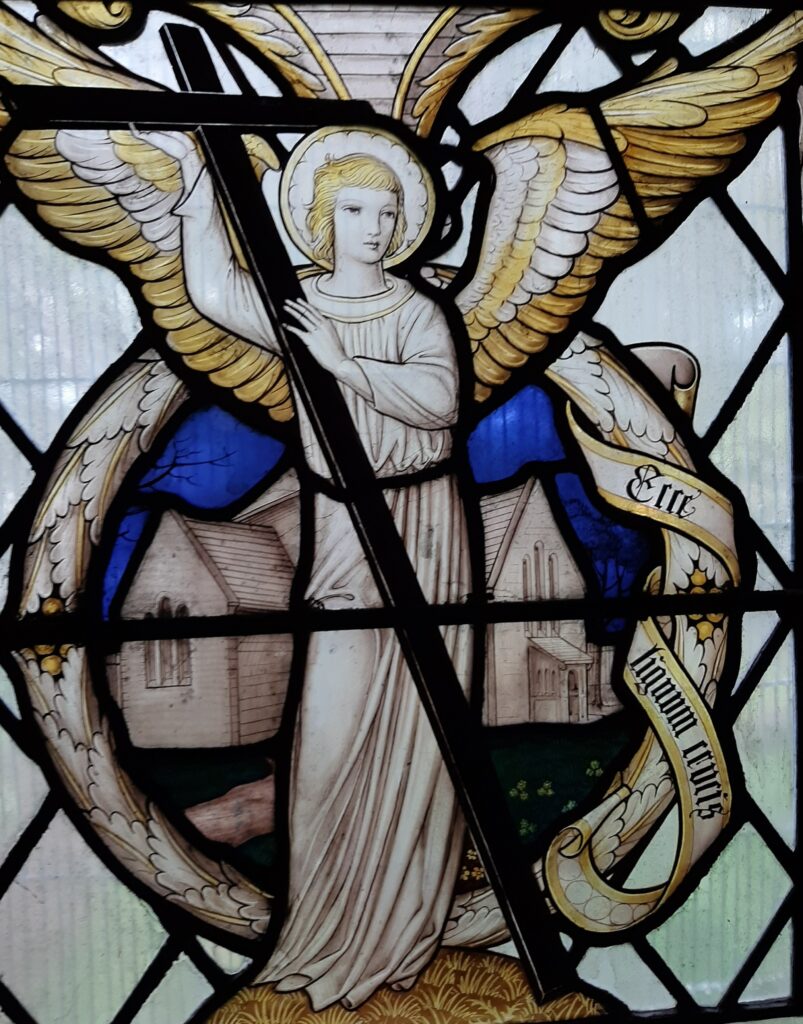+ ‘For the message of the cross is foolishness to those who are perishing, but to us who are being saved it is the power of God’
When a Church is consecrated it is given a title and a patron, usually a saint, and that is a special gift to those of us who worship there. Ours is the Church of the Holy Cross. The Cross is a special gift to us. You can’t get much better than that, it takes us to the heart of our faith. But why was it chosen?
As far as I can see, it is not clear why. Douglas suggested it was an Edinburgh dedication, from Holyrood Abbey, one not already taken by any church in the diocese. This seems to be confirmed by our east window. In between St Columba on Iona and St Cuthbert in front of our cathedral, we have a roundel showing our Church with an angel in front holding a big black cross. This is presumably the famous relic of the true cross, the Black Rood of Scotland (rood is the Anglo-Saxon word for cross); brought here by St Margaret and kept at Holyrood Abbey, to which it gave its name. It was stolen by the English and presumably destroyed in Durham at the Protestant Reformation. So, the name Holy Cross, together with the images of Columba and Cuthbert ties us into the Christian history of Scotland. In our secularised country, where knowledge of Christ is being swept away, it is a nice example of God’s sense of humour that the Scottish Parliament is popularly known as Holyrood, Christ’s Holy Cross.

110 years ago this beautiful building was dedicated to the Holy Cross, and given this day as its patronal feast. It is even built in the shape of a cross. If the title was chosen for historical reasons, what does it mean and what does it teach our community here today? There is a problem, the cross is an instrument of torture and death. In Jesus God became man. Instead of welcoming him we, because the human race is infested with sin, killed him in the most horrible way. Surely not a thing to celebrate. We killed God in the flesh. But you can’t kill God, Jesus is Life itself, and so he rose from the dead. But not only that, he came back in the flesh. And even that’s not the end as he call us, every one of us, to share in his victory through dying and rising with him in baptism and by eating and drinking his life-giving flesh and blood which we will do shortly. So todays feast takes us to the heart of our faith, which is that the cross is a sign of hope that death, sin and evil don’t have the last word.
This is good news in a society where we tend to ignore death until it grabs us by the throat. As we heard in the reading, ‘the message of the cross is foolishness to those who are perishing’, they push it aside, don’t mention it in polite society, only look backwards at funerals. But for those who are being saved, and we pray that we are among that number, ‘the message of the cross is the power of God’ over death. And how selfish we would be if we didn’t share this good news with those around us.
That’s our task here at Holy Cross, as it was in Douglas’s day, and in Bob’s day and in every day since the church was first founded in 1896 with services in a hall over the road. There is a huge amount that has happened here in the last few years, despite covid, and it has built on all the good work that has been done here before, so let’s give thanks for that and pray that we may hold fast to the message of the cross.
Today’s feast is called the Exaltation or ‘lifting up’ of the cross. It is a Jerusalem feast, commemorating the finding of the cross by the Empress Helena, the dedication of the Church on Golgotha, and the return of the cross in 629 after it was stolen by the Persians. Today’s gospel and first reading, with its weird snake on a pole, can help us understand this ‘lifting up’. Israel sinned in the desert and God sent snakes to punish them. Moses prayed for them and God didn’t tell him to put a snake-killing mongoose on a pole but an image of the snake itself which was killing them. Jesus in the gospel compares himself lifted up on the cross to the snake on the pole – why? For the Israelites snakebite was cured by a poisonous snake and for us death is cured by the death of God on the cross.
Today in music, through prayer and with a meal we celebrate our church of the Holy Cross and give thanks for our life together. We look forward to new things in the next few days, the ordination of our curate, Ross, and the new Franciscan Friary next door in Pilton established by our assistant priest, Br Joe. But at the heart of all our celebrations must be the good news of the Cross, shared with our God-forgetting world. Life and love win over sin and death, or in the famous song of the Eastern Churches: ‘Christ is risen from the dead, trampling down death by death, and upon those in the tombs bestowing life’.

